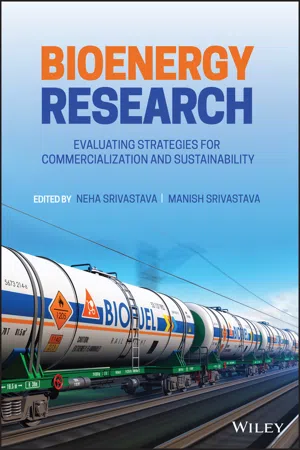
Bioenergy Research
Evaluating Strategies for Commercialization and Sustainability
- English
- ePUB (mobile friendly)
- Available on iOS & Android
Bioenergy Research
Evaluating Strategies for Commercialization and Sustainability
About This Book
BIOENERGY RESEARCH
Evaluates challenges and sustainable solutions associated with various biofuel technologies
Bioenergy Research offers an authoritative guide to recent developments in green bioenergy technologies that are currently available including: bioethanol, biobutanol, biomethanol, bio-oil, biohydrogen, biogas and biomethane. The authors provide in-depth analysis and discuss the commercial viability of the various technological advances in bioenergy. Comprehensive in scope, the book explores the environmental, practical and economic implications associated with a variety of bioenergy options. The book also considers the rollback of fossil fuels, the cost and their replacement as well as practical solutions for these issues.
This important resource:
- Presents up-to-date research and industrial developments for various bioenergy options
- Offers comparative evaluation of bioenergy technologies for commercial feasibility
- Reviews current challenges and sustainable solutions for a variety of biofuel technologies
- Contains a review of existing strategies for bioenergy production
Bioenergy Research is a valuable guide for academic researchers and industrial scientists working in the fields of biofuels and bioenergy, environmental science and technology, microbial technology, bioprocess engineering, and waste valorization.
Frequently asked questions
1
Role of Enzymes in Biofuel Production
1.1 Introduction
| With respect to | Benefits | Drawbacks |
|---|---|---|
| Price | Energy security Reduces the import of crude oil | High cost of manufacturing |
| Vehicles | Safe Produce less noise pollution Increases lubrication Increases ignition | Causes corrosion of engine |
| Pollution | Reduces the emission of CO2 and carbon particles Biodegradable Nontoxic in nature | Increases the emission of NO2 Increases the emission of aldehydes |
1.2 Biofuel Classification
| “First generation biofuels”(sources are starch, grain, and cereal seeds) | “Second‐generation biofuels”(sources are cellulosic mass, like w... |
|---|
Table of contents
- Cover
- Table of Contents
- Title Page
- Copyright
- List of Contributors
- Foreword
- Acknowledgments
- Biofuels Production Technologies: Recent Advancement
- 1 Role of Enzymes in Biofuel Production
- 2 Microbial Technology for Biofuel Production
- 3 Biohydrogen Production from Cellulosic Waste Biomass
- 4 Strategies for Obtaining Biofuels Through the Fermentation of C5‐Raw Materials: Part 1
- 5 Strategies for Obtaining Biofuels Through the Fermentation of C5‐Raw Materials: Part 2
- 6 An Overview of Microalgal Carotenoids: Advances in the Production and Its Impact on Sustainable Development
- 7 Microbial Xylanases: A Helping Module for the Enzyme Biorefinery Platform
- 8 Microbial Cellulolytic‐Based Biofuel Production
- 9 Recent Developments of Bioethanol Production
- 10 Algal Biofuels – Types and Production Technologies
- 11 Biomethane Production and Advancement
- 12 Biodiesel Production and Advancement from Diatom Algae
- 13 Biobutanol Production and Advancement
- Index
- End User License Agreement